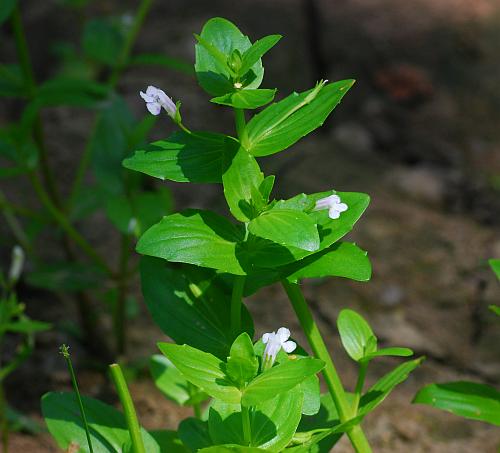Lindernia dubia (L.) Pennell
False Pimpernel

Native
CC = 4
CW = -5
MOC = 95
© SRTurner
Lindernia dubia (L.) PennellFalse Pimpernel | |
 |
Native CC = 4 CW = -5 MOC = 95 |
© SRTurner |
|
Family - Linderniaceae Habit - Fibrous-rooted annual forb, sometimes with a slender taproot. Stems - Loosely to strongly ascending, to 35 cm, often several from base, sometimes rooting at the lower nodes, unbranched or branched, 4-angled, glabrous or sparsely glandular-hairy, sometimes only near the base.
Leaves - Opposite, simple, sessile. Blades 5-16 mm long, lanceolate, ovate, oblanceolate, or obovate, occasionally nearly circular, rounded to sharply pointed at the base and tip, sometimes slightly clasping the stem, the margins entire or sparsely scalloped or toothed, the surfaces glabrous, but finely and inconspicuously gland-dotted.
Inflorescences - Axillary, of solitary flowers in the leaf axils, 2 per node or sometimes 1 per node and alternating on opposite sides at successive nodes, lacking additional bracts or bractlets, the stalks 0.5-30 mm long, glabrous or glandular-hairy.
Flowers - Cleistogamous flowers sometimes produced. Calyces 2.5-4.5 mm long at flowering, persistent and becoming slightly enlarged to 4.5-6.0 mm at fruiting, actinomorphic, deeply 5-lobed, the lobes linear to narrowly lanceolate. Open flowers with the corolla 4-10 mm long, pale bluish-tinged to nearly white externally, internally white except sometimes for pale blue markings, zygomorphic, bilabiate, the lips 2-3 mm long, the upper lip shorter than the lower one, irregular or somewhat notched at the tip, the lower lip about equally 3-lobed, bearded basally with a pair of low, thickened ridges in the throat, the throat not appearing closed by the ridges. Stamens 2, the filaments attached in the corolla tube, not exserted, the anthers attached near their bases, loosely fused, light yellow. Staminodes 2, the filaments fused to the corolla tube. Pistil 1 per flower, 2-carpellate. Ovary 2-locular, the placentation axile, with numerous ovules. Style 1, slender, often persistent at fruiting, the stigma 2-lobed, appearing capitate, the lobes somewhat flattened.
Fruits - Capsules 3-6 mm long, ellipsoid, tan at maturity, dehiscent along the 2 sutures. Seeds numerous, minute, 0.2-0.4 mm long, oblong-ellipsoid to somewhat polygonal, the surface with a fine network of ridges, yellow to reddish brown.
Flowering - June - October. Habitat - Streambanks, pond margins, sloughs, swamps, bottomlands, marshes, fens, also ditches, fields, railroads, roadsides, and moist, open, disturbed areas. Origin - Native to the U.S. Lookalikes - Gratiola neglecta. Other info. - This little species is found in moist to wet areas throughout Missouri. Its distribution within the continental U.S. comprises two disjunct ranges, one in the eastern half of the country and the other in west coast states. The plant can be identified by its habitat, square stems with sessile clasping leaves, and small, pale flowers with lavender markings. Another species, Gratiola neglecta, is similar in appearance but has bractlets subtending the flowers. Photographs taken in Van Buren, MO., 7-18-03 (DETenaglia); also at Busch Wildlife Area, St. Charles County, MO, 7-27-2011, Shaw Nature Reserve, Franklin County, MO, 7-17-2012, Allenton Access, St. Louis County, MO, 8-2-2020, and Catawissa Conservation Area, Franklin County, MO, 8-23-2021 and 9-14-2017 (SRTurner). |